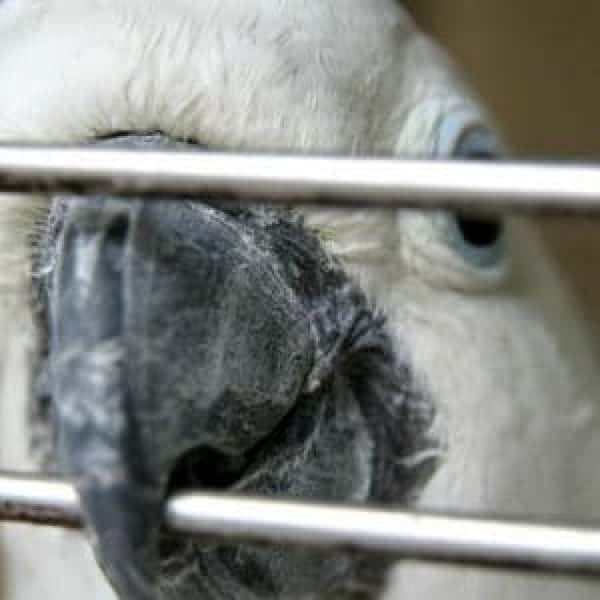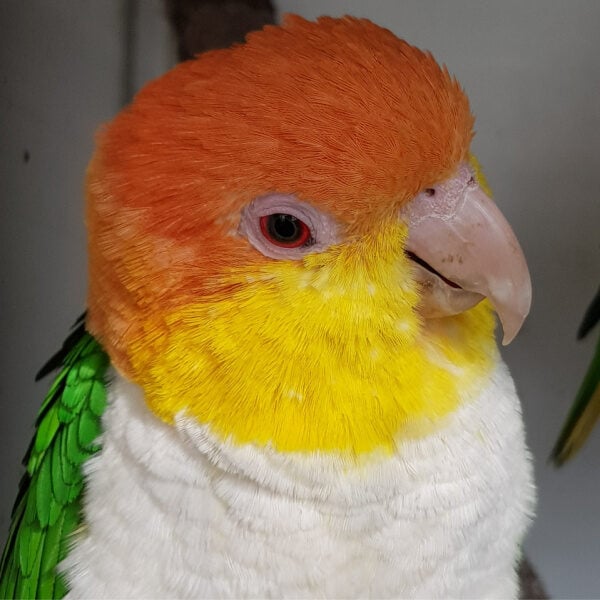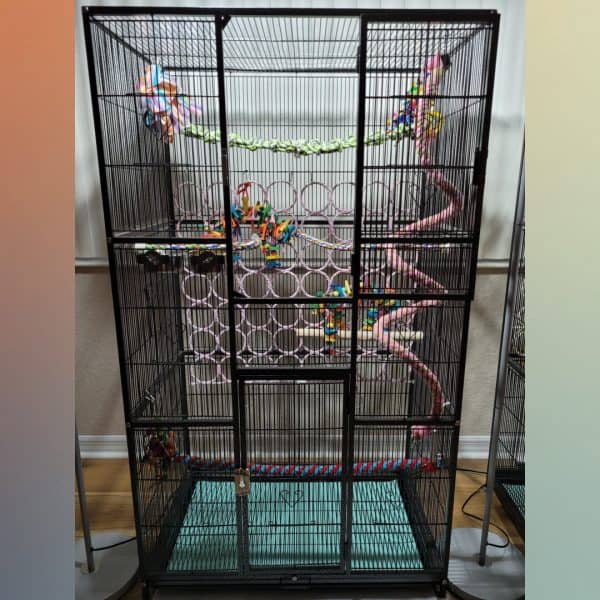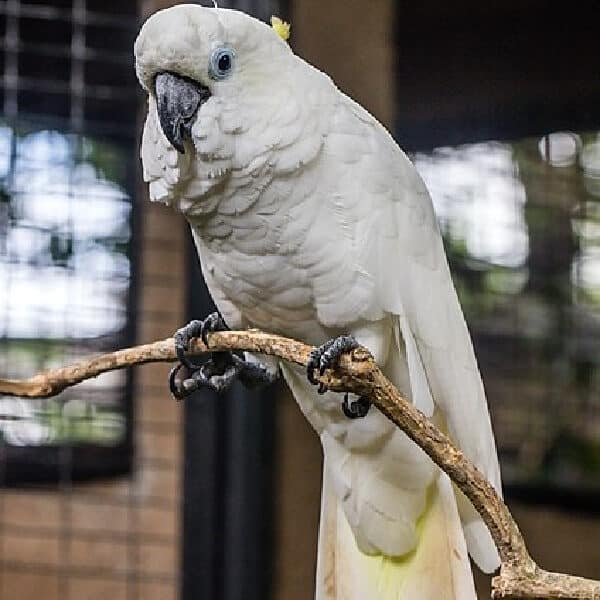Last Updated on by Mitch Rezman
This post was originally published 4/15/16
I’m feeling a bit cantankerous “hey you kids get off my lawn” and argumentative.
The source of which can be found in the second post in this week’s Birdie Brunch.
First a Popcorn update
I can’t with certainty say she is fine.
She still pants after flying.
She has this hernia like protrusion in her abdomen but the good news is we haven’t seen any fluid build up for a couple of weeks.
We’re back to our morning routine of her following me in flight around the apartment.
I sit down to work she likes to be either on a keyboard or part of my desk or my leg and will headbutt me until I give her scritches. Every day she is with us is a gift
Let’s start with Marilee
A suggestion on cleaning parrot cages.
Put parrot in your temporary traveling cage and take its cage to the manual car wash and power wash it like a car. Make sure to wax and rinse thoroughly.
Make sure you have all seeds in the trash before you begin, to be kind to car wash owner.
Wrong on a number of levels Marilee
First you’ll need a vehicle large enough to transport the birdcage to said car wash. The other problem is that you are doing more damage than good by effectively “power washing” your bird cage.
I know a lot of you men reading this have recently acquired a 2300 pound or 2600 psi power washer and are dying to show your wife how clean it will make her bird’s cage.
This is a multidimensional issue. The bars on the sides and top and bottom of the cage are solid pieces of metal. At the very least, the four corner posts of a bird cage are square hollow tubular steel.
If you have a cheap no-name birdcage that you bought off of eBay, the power washing or the car wash scenario may begin to peel off the powder coating on your birdcage.
If you have a name brand birdcage I want you to note that the four corners of the cage are going to be “tubular” steel, as in hollow in the middle. This means that in spite of your good intentions in all that wonderful powder coating that you performed research about prior to purchasing the cage – the tubular steel interior of the four corners of the cage and some of the horizontal tubular components will retain water.
This water on the interior of the tubular components of your birdcage will cause something called oxidation over time something better known as “rust”.
So have at it weekend warrior. Chain your cage to the car wash linkage and drag it out to the backyard and blast it with water at pressure greater than Niagara Falls.
The question then becomes how many bird cages do you want to buy in your bird’s lifetime?
A far more simple and eloquent solution is to leave your bird’s cage right where it is. Use Poop Off every day or two to clean the food particulate and poop from the metal.
Every few weeks take your handheld steam cleaner – I’d love to sell you one but we can’t find them priced reasonably enough right now so you’re on your own – and sip your coffee while the steam cleans and sanitizes not only the cage but all of the toys and accessories in the cage.
What about the seed guards you ask? Seed guards do not keep the bird cage area any cleaner. Seed guards become four more pieces of metal that need to be cleaned. They also are a danger to animals, small children and people who aren’t watching where they’re going. Ditch the seed guards and put them flat on the floor somewhere or in the closet so you don’t fall and take someone’s eye out.
Okay it’s time to argue with more bird people.
How do I stop my bird from plucking all his feathers?
Well there’s a lot of answers to that – first you have to have the bird checked out by a vet and then examine its nutrition and environment.
– so no there is no definitive recommendation to eliminate feather plucking.
Should I clip my bird’s wings?
All that depends on how comfortable you are with a flighted bird. If you are going to work on training your bird. There are several factors. – so no there is no definitive recommendation whether to clip a bird’s wings or not.
If I decide to clip my bird’s wings how many feathers should I cut off?
There are several schools of thought on that. You can have a bird that is allowed to glide from the top of the cage or that falls like a boulder – it’s two different clips – There are a number of ways to approach that – so no there is no definitive recommendation on how to clip how bird’s wings.
How do I get my cockatiel to stop laying eggs?
Some experts recommend extended ranges of darkness to trick the bird into thinking breeding season is over.
Other experts feel that extended hours of light should be introduced to shutdown the birds circadian clock – so no there is no definitive recommendation on how to shut down a prolific egg laying birds reproductive system.
Are pellets better for my bird than seeds?
That depends upon the species – grass parakeets are seed eaters. Your bird might not convert easily to pellets.
You may require a seed blend with a supplement. Or a seed blend with pellets. Avicakes can provide both – so no there is no definitive recommendation on whether to serve my bird pellets or seeds.
BUT
When it comes to the size of the cage there are absolute recommendations backed up by data and information on the Internet and the measurement of birds wings by avian veterinarians.
Ebay Bird Cage Buying Guide:
“No matter what species the bird belongs to, though, the cage must be big enough to allow space for walking, climbing, and flying.
A good cage, even for a small bird, is much bigger than what most people picture when they think of a bird cage.
Exactly how big is big enough varies depending on which expert makes the recommendation, but a width three times as wide as the bird’s wingspan is a good place to start. This means a budgie with a 10-inch wingspan needs a cage almost 3 feet wide on its shortest side.”
Purdue University, College of Veterinary Medicine:
“When purchasing a bird, consider its wingspan; the cage you house the bird in should be at least twice the bird’s wingspan in width, length, and depth.”
avianwelfare org:
“Cages for singly-housed larger birds should be at least one and a half times
the bird’s natural wing span in all directions. Ideally all birds should have cages/aviaries large enough to accommodate flight.”
The Gabriel Foundation:
“Minimum cage sizes: Parrot species need a minimum of 2-3 x the wingspan in width and depth”
Pet education.com:
“Cage Size for medium to large size birds, the cage living area (does not include space between floor grate and tray floor) should be a minimum of 1-1/2 times your bird’s adult wingspan in width, depth, and height. This allows comfortable movement and may reduce the risk of feather damage. For smaller birds, a cage should provide the room needed for flying.”
Book: The Ultimate Guide to Parrots:
“Take the wingspan and multiply by three. This gives you an idea of the smallest depth the cage should be. Now multiply by 2.5 the wingspan for the minimum width of the cage.”
Wylds Wingdom:
“A general rule of thumb is that for large birds, the interior living space of the cage should be at least 1.5 times the bird’s adult wingspan – in depth, width and height.”
I ask the experts – how can you be so certain in one area and so vague and a dozen other areas of caged bird care? My answer is and always will be the size of birdcage doesn’t matter.
What are the best cage dimensions for multiple bird’s. Double double?
To begin with everybody is predicated the size of the cage, wingspan of the bird and then I don’t know 20% of you 50% of you clip your bird’s wings. A green ring macaw has a 47 inch wingspan. 1.5 times that wingspan is 70 1/2 inches. Two times a wingspan is 94 inches.
Thus the minimum enclosure recommended by the experts is 86″ x 62″.
But if I clipped the bird’s wings let’s say 10 inches neither side making wingspan 20 inches shorter the total size size of a of a major Mitchell’s cockatoo.
Does my clipped Green wing macaw now only require a 64 inch wide cage?
You can call it a trick question but it’s something to consider. The bigger question that gets begged is one of the assumptions of how the bird toys, letters, her shoes and accessories and feeders are arranged in the cage.
If our cagescaping is based upon the cage canopy theory, the birds can have room to spread its wings regardless of the size of the cage unless you’re talking a walk-in aviary.
If you have a family of five humans obviously I would not recommend a Porsche. But nobody can tell you that it’s essential that you have a minivan which is what the wingspan cage size correlation does.
Let’s look at this subject holistically. The cage has to fit into your home. Besides the cage when the bird comes out of it where is it going to be? I’m not a big fan of putting Green wing macaws on six-foot tall play top bird cages for aggression reasons.
A practical solution is a place stand which is introducing more avian equipment and your home eating up more real estate while saving your furniture.
Bird cages are there to protect the bird from itself. To advocate a big enough cage to allow the bird to flap its wings has drawbacks. Do you really want your Moluccan cockatoo pushing seed hulls, shredded paper, dried food particulate and fecal dust out of the cage and into your home more efficiently than a Dyson fan?
I want the wing flapping out of the cage which only pushing the dust around my house that will always be there living in the city.
Find a cage that you, your family and your bird can agree on. Make sure the metal is sturdy enough to contain the bird. And don’t make yourself crazy with this bar spacing thing. Half the manufacturers measure the bars from the center of the bar the center of the next bar.
Other manufacturers list the bar spacing actually between the bars. We had two Indian ringnecks in an old California cage that had 1 inch bar spacing.
What you should be more concerned with, something that I don’t hear any of these experts squawking about is the security of the cage and how easy it is to escape from – or not – leaving you with this video to ponder.
written by mitch rezman
approved by catherine tobsing
your zygodactyl footnote
Author Profile
Latest entries
 The Traveling BirdJune 26, 2025Can You Name 5 Parrot Species That Are Living Wild in the USA?
The Traveling BirdJune 26, 2025Can You Name 5 Parrot Species That Are Living Wild in the USA? Bird BehaviorJune 26, 2025How is it Parrots Are Problem Solvers Social Animals and Even Use Tools?
Bird BehaviorJune 26, 2025How is it Parrots Are Problem Solvers Social Animals and Even Use Tools? Bird & Parrot AnatomyJune 25, 2025How a Tiny Chemical Modification Makes Parrots Nature’s Living Paintings
Bird & Parrot AnatomyJune 25, 2025How a Tiny Chemical Modification Makes Parrots Nature’s Living Paintings PigeonsJune 20, 2025How Do Parrots Thrive in Cities Outside Their Native Habitats?
PigeonsJune 20, 2025How Do Parrots Thrive in Cities Outside Their Native Habitats?




